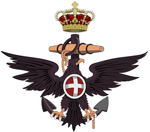RN Leonardo da Vinci, one of the newest RM battleship was lost due to Austro-Hungarian sabotage in 1916, then recovered thanks to an extraordinary engineering effort (a base for the Hochseeflotte hulls in Scapa Flow).
The hull, raised and flipped over, was found in good condition. The total expenses for recovery was about 12 million Lire.
After the end of the war, a significant discussion about its destiny (and the destiny of the RN Caracciolo, the far more advanced fast battleship whose building was stopped after launching) took place.
In 1921 after 100 million Lire had already be canceled to end the RN Caracciolo, a special commission stated it was worth of it to rebuild the ship, with a cost estimated between 31 and 54 million Lire, introducing improvements thanks the materials freed by the Caracciolo cancellation. The commission conducted test on 1/2 and 1/20 models to evaluate underwater protection, as well as a study showing a 1,5k of max speed could be achieved with minor changes to the engines.
Main changes:
central MCG canceled;
no central casemate, replacement of the 18/120 with 12 or 14/152 coming from RN Caracciolo;
16/102 in place of 19/76;
new tripod and fire control;
better disposition of the magazine;
conversion to oil of four boilers;
better bulkheads;
better horizontal armor (14 cm.)
At this point the expense estimate was already up to 73 million Lire.
After the Washington treaty, and in depth financial analysis, it was evident that reconstructing the ships was more a prestige issue than an operational choice. RN Leonardo da Vinci was a canceled from the warship registry on March, 26, 1923.
Of course, both RN Caracciolo and RN Leonardo da Vinci would had been a good choice for an experimental aircraft carrier for the RM, but this belongs to another story.
Source: “La fine della corazzata Leonardo da Vinci”, C.V. Antonio Severi, Bollettino d’archivio dell’ufficio storico della Marina Militare, Anno IV, marzo 1990.


